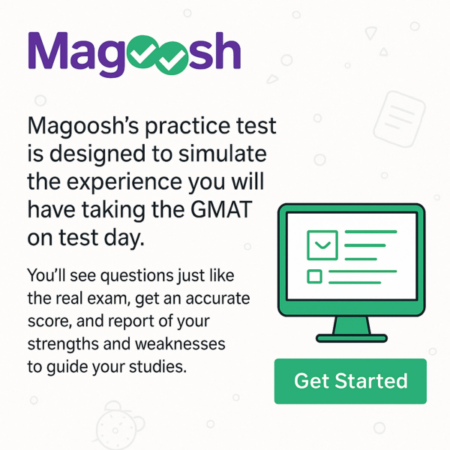
What exactly is the GMAT Focus Edition? It’s the Graduate Management Admissions Council’s (GMAC) shorter, 2-hour-and-15-minute exam for MBA applicants. The key changes are that the total score now ranges from 205 to 805, and the test now consists of three equally-weighted sections: Verbal Reasoning, Quantitative Reasoning, and Data Insights.
This article covers everything you need to know about the present-day version of the GMAT: the exam format, timing, sections, and why “GMAT Focus” or “GMAT Focus Edition” are outdated names.
Historical Context: Why Did the GMAT Change to the GMAT Focus Edition?
In November 2023, GMAC launched the GMAT Focus Edition—a redesigned version of the classic GMAT. The change was intended to better reflect or “focus” on the skills most relevant to business school success today: data interpretation, critical thinking, and strategic reasoning. The “Focus Edition” part was added to help differentiate between old and new forms of the exam during the transition period.
But the term “Focus Edition” was never meant to be permanent.
What Happened and What’s Current: On July 1, 2024, GMAC dropped the “Focus Edition” label and reverted to simply calling it the GMAT Exam—because this is now the only version of the test available. The classic exam pattern had been fully retired as of January 31, 2024.
What Changed from the Classic GMAT to GMAT Focus Edition?
The exam underwent a structural and strategic transformation, making it more efficient and skills-focused.
| Feature | Classic GMAT | GMAT Focus Edition |
|---|---|---|
| Total Sections | 4: Quant, Verbal, Integrated Reasoning, AWA | 3: Quant, Verbal, Data Insights |
| Test Duration | ~3 hours, 7 minutes | 2 hours, 15 minutes |
| Writing Section | AWA included | ❌ Removed |
| Integrated Reasoning | Scored separately | ✅ Replaced by Data Insights |
| Sentence Correction | Yes | ❌ Removed |
| Geometry | Yes | ❌ Removed |
A Real Student’s Test Day Experience for the GMAT Focus Edition
Here’s a firsthand look at the test day experience from someone who has taken the GMAT Focus Edition (that is, the present-day GMAT):
Scoring Changes for the GMAT Focus Edition
- Total Marks: 205–805 (previously 200–800)
- Each Section: Scored from 60 to 90 (previously no individual section scores given)
- No Separate IR or AWA Scores: Only one composite score now
- Composite Derived From Three Sections: Verbal, Quantitative, and Data Insights (previously only Verbal and Quant)
- Enhanced Score Report: Now free! Includes breakdowns of performance by skill, question type, and timing. Example reports are available at MBA.com
Do you need to convert your old GMAT score to a new GMAT Focus score? If so, use our GMAT Score Chart to handle the conversion.
Study Tips for Each Section of the Focus Edition Exam Pattern
Quantitative Reasoning
On the Quantitative Reasoning section, you’ll solve 21 problem-solving questions in 45 minutes.
Content Focus:
Arithmetic, algebra, statistics—no plane geometry. However, coordinate geometry concepts are categorized as algebra (slopes, equations of lines, and x-y coordinates) and are still tested.
Tips:
- Emphasize real-world math reasoning. Use estimation and logic to save time.
- Strengthen your skills in arithmetic, algebra, and coordinate geometry concepts.
- Prioritize areas like number properties, word problems, and data interpretation.
- Do timed mock tests regularly to improve speed and accuracy.
- Work on time management to ensure you don’t spend too long on any one question.
- Reviewing your mistakes and understanding the underlying concepts will be key to improving your performance.
Learn more about the Quantitative Reasoning section by trying out some free practice problem-solving questions.
Verbal Reasoning
You’ll face several different passages on the Verbal Reasoning section, for a total of 23 multiple-choice questions in 45 minutes.
Content Focus:
Reading Comprehension + Critical Reasoning only
What’s Gone:
Sentence Correction (no more grammar questions!)
Tips:
- Practice logical structure analysis and active reading.
- Strengthen argument evaluation and overall reading comprehension.
- Practice reading passages quickly and identifying key points to answer questions more efficiently.
- For critical reasoning, strengthen your ability to spot logical flaws and assumptions in arguments.
- Consistency in practice will help build confidence for test day.
It’s helpful to read a variety of materials that reflect the complexity and structure of GMAT passages. Focus on the following:
- Nonfiction Articles: Read articles from reputable sources like The Economist, The New York Times, or Scientific American. These offer dense, analytical writing similar to GMAT reading comprehension passages.
- Essays and Opinion Pieces: Opinion articles and essays help hone skills in critical reasoning by engaging with arguments, assessing logic, and identifying key points.
- Business and Economics Journals: Since the GMAT often includes passages related to business, economics, and social sciences, these journals can be especially useful.
Learn more about each of the Verbal Section’s question types.
Data Insights
This is a very unique section as it’s a hybrid of Integrated Reasoning questions and Data Sufficiency questions. You’ll encounter 20 total questions in 45 minutes. Here’s a full breakdown:
- Data Sufficiency
- Table Analysis
- Multi-Source Reasoning
- Graphics Interpretation
- Two-Part Analysis
Calculator Allowed:
This is the one section that allows the use of a calculator on the GMAT. It’s a great tool but must be used wisely, or it could hinder more than help.
Tips:
- Master the art of synthesizing complex data.
- Look for patterns and relationships across formats.
- Focus on interpreting data from charts, tables, and graphs.
- Practice identifying trends and key information quickly.
- Be comfortable with basic statistics like mean, median, and range, as they often appear in questions.
- Manage your time effectively, and avoid overcomplicating problems with unnecessary calculations.
- Regular practice will help improve both your analytical skills and accuracy in interpreting data.
Learn all about the Data Insights section’s unique question types—and try some out for yourself!
Can I Use Old GMAT Materials to Study?
We understand why you’d ask. There is A LOT of old material out there. The answer: Yes—but selectively. Here’s how to repurpose your prep:
| Content | Keep or Skip? | Notes |
|---|---|---|
| Critical Reasoning | ✅ Keep | Unchanged in Focus Edition |
| Reading Comprehension | ✅ Keep | Still part of Verbal |
| Problem Solving (Quant) | ✅ Keep | Still tested, minus geometry |
| Data Sufficiency | ✅ Keep | Now part of the Data Insights section |
| Sentence Correction | ❌ Skip | Removed entirely |
| AWA Essays | ❌ Skip | Writing task eliminated |
| Integrated Reasoning | 🔁 Adapt | Content and question format still valid but structure is different |
If you’ve already studied for the old GMAT, or have older prep material, use the above table as a guide, and focus your efforts on the following: problem-solving, critical reasoning, and data analysis. Adjust your practice to reflect the new pacing and section structure.
What Needs to Change in Your GMAT Study Strategy?
Shift from memorization-based prep to strategic reasoning and decision-making. Five key adjustments:
- No Grammar Cramming: Forget verb tense rules and modifier placement—Sentence Correction is gone.
- More Emphasis on Data: Learn to analyze tables, charts, and multi-source datasets quickly.
- Time Management Is Tighter: With only 45 minutes per section, pacing is more demanding.
- Section Flexibility: Practice taking sections in different orders to see what suits your test-day rhythm.
- Updated Pacing Strategy: Your pacing and decision making must now factor in the new ability to review and change your answers, as we’ll see below.
GMAT Focus Edition’s Question Review & Edit Feature
The answer change feature allows you to revisit and modify up to three answers per section as long as there is time remaining. While this feature introduces a modicum of flexibility, it also poses potential risks.
Pros:
- Correct Mistakes: Helps you revisit and correct errors, which could boost your score.
- Flexibility: Reduces pressure by allowing answer changes, enhancing confidence.
- Time Efficiency: Flags questions for review to save time during the first pass.
Cons:
- Time Management: Spending too much time on reviews can affect overall timing.
- Overthinking: Ability to change might lead to second-guessing and mistakes.
- Limited Changes: Only three changes per section, making it crucial to use them wisely.
Effective Strategies:
- Prioritize questions you’re unsure of but not completely stuck on.
- Practice timing to balance review without sacrificing speed.
Consider This:
This feature is new to the GMAT, so empirical research is still emerging. However, existing studies from other standardized tests (like the SAT and GRE) suggest:
- Changing your answer is typically only beneficial if you do so with a clear reason. For example, if you are 100% sure you misread, miscalculated, or made some other type of specific error.
- Students tend to change right answers to wrong ones when second-guessing is based on anxiety, not sound logic.
Key Takeaway: Use this feature primarily as a pacing tool. On a question you’re really unsure about, make a guess so you can move on, mark the question for review and then revisit with any remaining time.
How Long Should You Study?
Most successful students dedicate 100–120 hours over 2–4 months. Variables that affect your timeline:
- Starting proficiency
- Target score
- Weekly availability
- Comfort with data-heavy questions
Here’s a breakdown by timeline and test-taker type:
| Timeline | Best For |
|---|---|
| 1–2 months | Strong academic background, limited time |
| 3 months | Working professionals with moderate availability |
| 4–6 months | Beginners or those aiming for top 10 B-schools |
Use Magoosh’s GMAT study schedules to incorporate daily practice, lessons, and periodic full-length mock tests.
Final Thoughts
Have more questions about the present-day GMAT? Take a look at our full guide in our article What is the GMAT?
The GMAT Focus Edition is leaner, faster, and more focused than its predecessor—but it’s also a challenge that rewards clear reasoning, strategic time use, and a calm test-day approach.
Whether you’re just starting or adapting from older prep, Magoosh is ready to help you conquer this new format with smart tools, clear instruction, and personalized support.
Check out Magoosh’s free full-length GMAT mock test, which includes a free score report to help you get a sense of where you’re starting from. Also, check out a Magoosh GMAT Premium Plan for everything you need to succeed!






